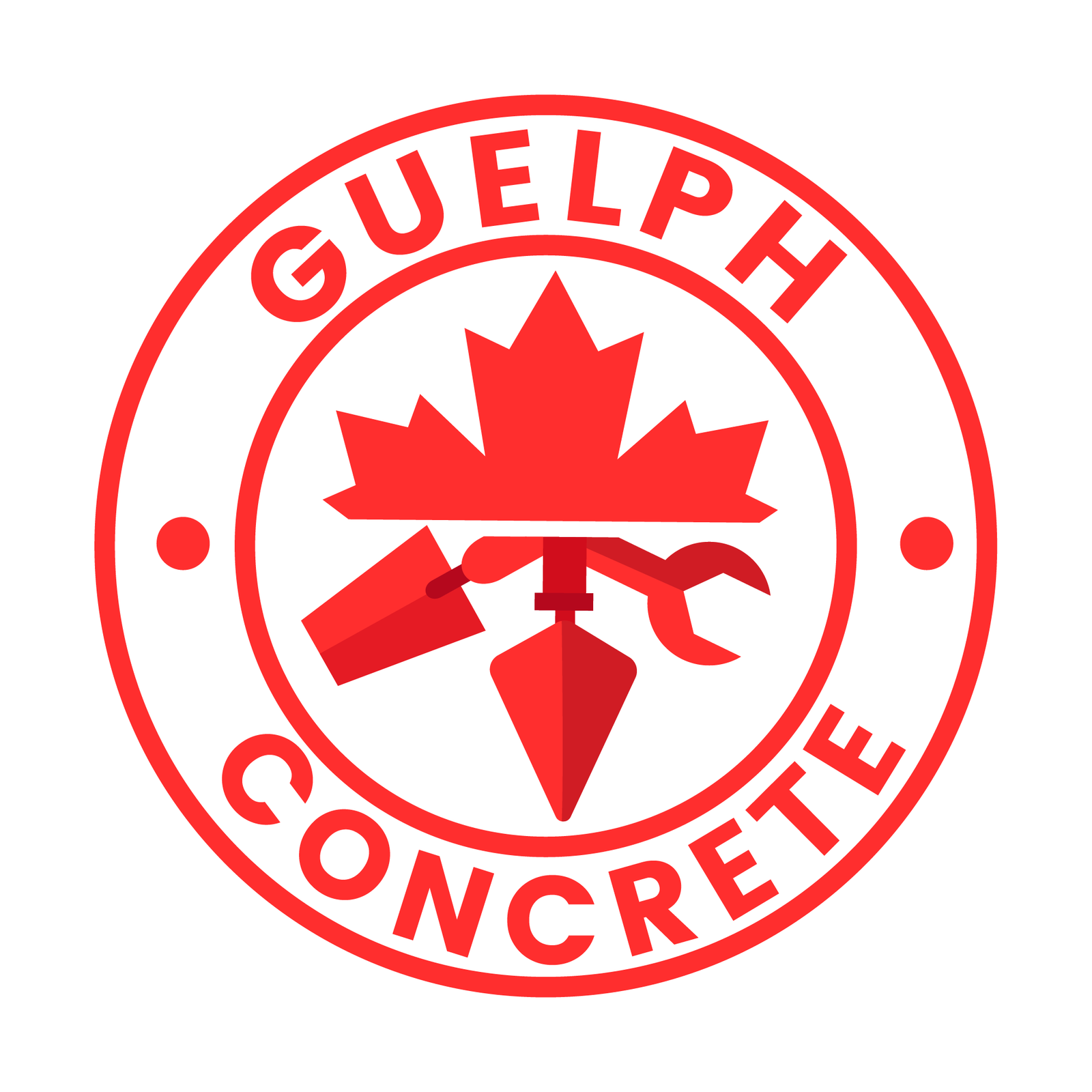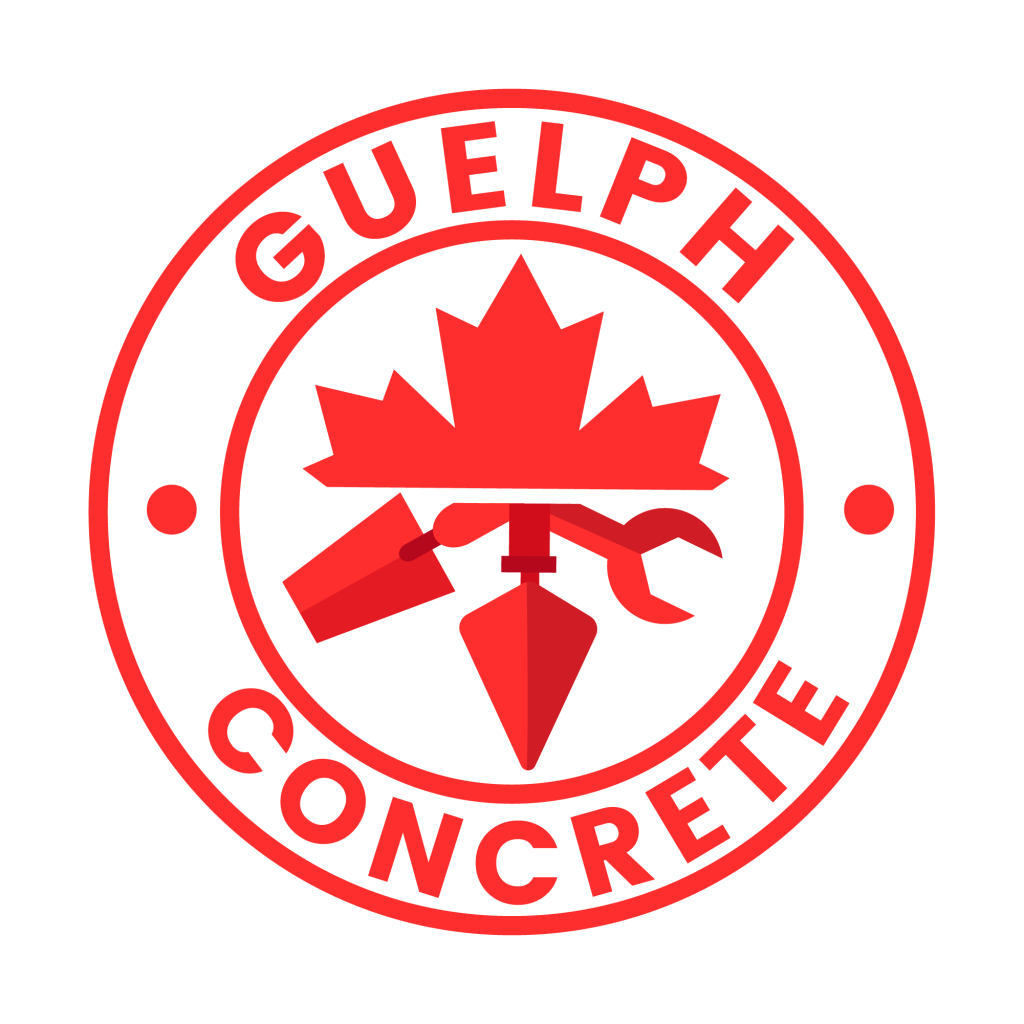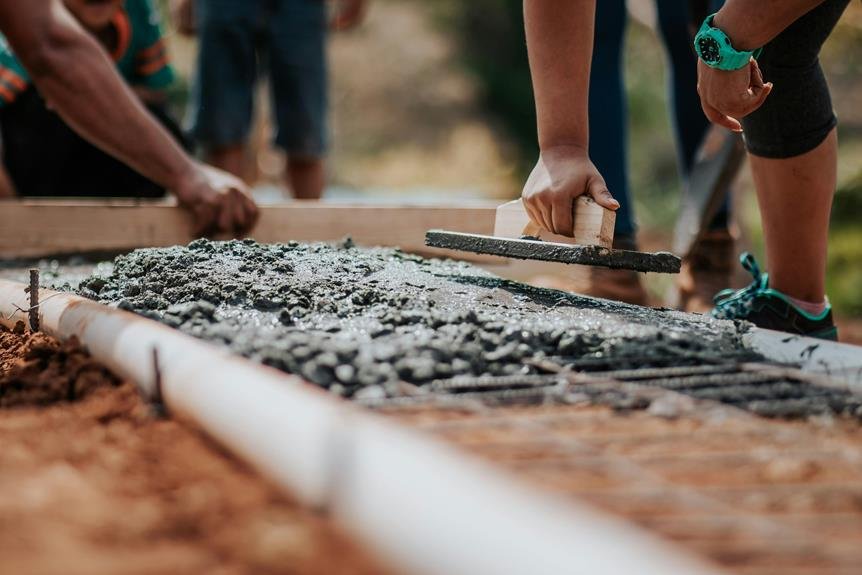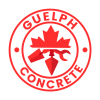To waterproof a concrete block foundation in Guelph, Ontario, Guelph Concrete LTD, a trusted name in the industry for over 15 years, follows a meticulous process.
We start with a thorough inspection to identify cracks, efflorescence, or mold. Once the surface is cleaned, we seal any gaps with hydraulic cement to ensure a sturdy base.
Next, we apply a waterproof membrane like Bakor Blueskin WP200, making sure to overlap the edges for a seamless barrier.
To further enhance water management, we install a drainage board such as Bakor WP 2000. Our team then excavates to the proper depth, repairs any larger issues, and backfills with gravel to ensure optimal drainage.
Regular maintenance and professional oversight can significantly extend the lifespan of your foundation.
For a comprehensive solution to all your waterproofing needs, contact Guelph Concrete LTD for a free estimate at 548-490-2074. Let our years of expertise work for you!
Importance of Waterproofing
Securing proper waterproofing for concrete block foundations in Guelph is important to prevent water infiltration and structural damage. As a community, we acknowledge the value of strong, durable homes. Proper waterproofing is key to our foundation’s longevity and structural protection. By keeping water out, we’re not only preserving the integrity of our homes but also safeguarding our investment for years to come.
Water infiltration can lead to moisture buildup, which is a breeding ground for mold. Mold prevention is vital as it directly impacts our health and well-being. By waterproofing our concrete block foundations, we can significantly reduce the risk of mold growth and the associated health hazards. This proactive approach ensures that our living spaces remain safe and comfortable for our families.
Moreover, addressing any existing cracks or vulnerabilities during the waterproofing process is crucial. These small issues can become major problems if left unchecked, compromising the structural protection of our homes. Effective waterproofing solutions aren’t just a temporary fix; they can prolong the lifespan of our concrete block foundations, ensuring they stand the test of time.
Together, we can create a safer, healthier environment for everyone.
Assessing Foundation Condition

To maintain the benefits of waterproofing, we must first evaluate the condition of our concrete block foundation for any existing issues. Start by thoroughly examining the foundation for cracks. While minor cracks might seem harmless, they can become pathways for water infiltration.
Pay close attention to any signs of efflorescence, mold, or mildew, as these indicate water penetration and could compromise the integrity of our foundation.
Next, let’s utilize waterproofing inspection techniques to check the structural integrity of our foundation. Look for any bowing or shifting blocks that might suggest underlying issues. It’s important to identify these problems early, as they could worsen over time and lead to significant damage.
Additionally, evaluate the drainage around our foundation. Poor drainage can create water entry points, exacerbating any existing issues. Check for pooling water or areas where water flows towards the foundation. Proper drainage is vital for maintaining a dry and stable foundation.
For a thorough understanding, consider hiring a professional to inspect and evaluate our foundation’s waterproofing needs. They can provide an expert evaluation and recommend appropriate solutions.
Exterior Waterproofing Methods

At Guelph Concrete LTD, a trusted concrete company in Guelph, Ontario with over 15 years of experience, we understand the importance of effective exterior waterproofing methods.
Allow us to guide you through our process, starting with the application of the Bakor WP200 waterproofing membrane, which provides a robust barrier against moisture.
Next, we install the Bakor WP 2000 water drainage and protection board to enhance water management and ensure optimal performance.
Finally, we meticulously handle the essential steps of excavation and backfill, guaranteeing your foundation is properly sealed and protected.
For a free estimate on our top-notch waterproofing services, contact Guelph Concrete LTD today at 548-490-2074.
Let’s help protect your home from moisture damage!
Waterproofing Membrane Application
Applying a waterproofing membrane to a concrete block foundation involves carefully adhering Bakor WP200 products to the exterior surface, establishing a strong barrier against water infiltration. One of the major benefits of the waterproofing membrane is the durable protection it offers, thanks to its resilient material and the manufacturer’s warranty. This guarantees that our foundation stays dry and secure for years to come.
Let’s explore the membrane application techniques.
First, we need to clean the concrete surface thoroughly, removing any dirt, loose particles, or previous coatings. A clean surface guarantees that the Bakor WP200 adheres properly.
Next, we apply a primer to enhance adhesion. Once the primer is dry, the waterproofing membrane is rolled out and pressed firmly against the foundation, starting from the bottom and working our way up to avoid air pockets. Overlapping the edges by a few inches ensures a seamless barrier.
Drainage Board Installation
Why is the installation of a drainage board like the Bakor WP 2000 significant for the exterior waterproofing of concrete block foundations in Guelph?
Well, it’s simple: these drainage boards play a key role in preventing water entry and safeguarding our foundations. The Bakor WP 2000, specifically, offers a robust barrier that directs water away from the foundation, ensuring we maintain dry and stable basements.
The benefits of using drainage boards are numerous. They provide an additional layer of defense against moisture and help prolong the life of our waterproofing membranes.
Proper installation techniques are essential for maximizing these benefits. Skilled technicians meticulously install the Bakor WP 2000, ensuring it’s securely attached and adequately covers the foundation’s exterior. This expertise guarantees the drainage board functions effectively.
Maintaining our drainage boards is equally important. Regular checks can help us spot any issues like cracks or detachment early on. Troubleshooting tips include inspecting the board for damage and ensuring it remains firmly in place.
If we encounter any problems, consulting the manufacturer’s guidelines or reaching out to a professional can help us address them promptly, keeping our foundations well-protected.
Excavation and Backfill
When we address the task of excavation and backfill for exterior waterproofing, we’re laying the groundwork for a sturdy foundation defense against water intrusion. The process starts by carefully digging around the foundation to expose the outer walls. This step allows us to tackle any cracks or weaknesses, ensuring a thorough waterproofing job.
Achieving the correct digging depth is vital. We usually dig down to the base of the foundation or slightly below, ensuring we can apply waterproofing materials to the entire surface. Once the waterproofing layer is in position, we proceed to backfilling.
Here’s our step-by-step approach:
- Digging: Excavate around the foundation to the appropriate depth, ensuring the entire outer wall is revealed.
- Examination and Repair: Inspect the foundation for any cracks or damage and fix them before moving forward.
- Waterproofing Application: Apply waterproofing membranes or coatings to the exposed foundation walls.
- Backfill Compression: Utilize gravel for backfilling, ensuring proper compression to encourage drainage away from the foundation.
Proper backfill compression is necessary to prevent future settling and water accumulation. By using gravel, we establish a natural drainage system that diverts water away from the foundation, safeguarding your home from water damage in the years ahead. Together, these steps constitute a dependable strategy for upholding a dry and protected basement.
Materials and Tools Needed

At Guelph Concrete LTD, with over 15 years of expertise in the concrete industry in Guelph, Ontario, we know how crucial it’s to effectively waterproof your concrete block foundation. To ensure top-notch results, we’ll utilize the right materials, tools, and safety gear.
This includes high-quality waterproofing membranes, drainage boards, sealants, a trowel, caulk gun, and a waterproofing brush. Additionally, we always prioritize safety by using gloves and goggles for protection.
Trust Guelph Concrete LTD to be well-prepared to tackle your waterproofing project efficiently and safely. Contact us today for a free estimate at 548-490-2074.
Essential Waterproofing Materials
A thorough waterproofing project for a concrete block foundation requires specific materials and tools to guarantee long-lasting protection against water intrusion. By selecting the right waterproofing membrane and confirming its compatibility with other materials, we can enhance the effectiveness of our efforts.
First, let’s discuss the Bakor Blueskin WP200 membrane. This high-performance, self-adhering waterproofing membrane is a top choice for many in Guelph due to its durability and ease of application. When it comes to application techniques, following the manufacturer’s guidelines ensures best performance.
In addition to the waterproofing membrane, proper drainage solutions are crucial. Weeping tiles and sump pits help direct water away from the foundation, reducing the risk of water damage.
Concrete sealers and foundation coatings are also necessary. These materials create an additional barrier, protecting the concrete block foundation from water intrusion and enhancing the overall durability.
Here’s a quick rundown of the essential waterproofing materials:
- Bakor Blueskin WP200 membrane – for superior waterproofing.
- Concrete sealers – to add a protective layer.
- Foundation coatings – for added durability.
- Weeping tiles and sump pits – to confirm proper drainage.
Necessary Application Tools
Let’s explore the essential tools and materials we need to guarantee a strong waterproofing job for our concrete block foundation.
First, surface preparation is key. We’ll need a sturdy wire brush to scrub away dirt, loose debris, and any old paint. This confirms our foundation is clean and ready for the next steps.
Next, for crack filling, we should have hydraulic cement on hand. This versatile material is perfect for sealing any cracks or gaps in the concrete blocks, providing a solid base before we move on to the sealant application.
Now, let’s talk about the waterproofing sealant. This is our primary defense against water intrusion. Using a high-quality masonry brush, we’ll apply the sealant evenly over the entire surface. This ensures thorough coverage and long-lasting protection.
Don’t forget about protective gear usage. Safety is paramount, so we’ll need gloves, goggles, and perhaps a mask to protect ourselves from dust and chemicals during the process.
Proper Safety Equipment
Before we dive into the waterproofing process, we need to make certain we’re equipped with the right safety gear to protect ourselves from potential hazards. Adhering to safety precautions is vital when dealing with various waterproofing techniques and materials.
First, let’s gather our protective gear to make sure we’re shielded from chemicals and debris:
- Gloves: These shield our hands from harsh chemicals and sharp objects.
- Safety Goggles: Essential for protecting our eyes against splashes and dust.
- Dust Mask: This prevents us from inhaling harmful fumes and particles, especially important when working with waterproofing products.
- Boots: Sturdy footwear protects our feet from debris and provides a good grip on slippery surfaces.
Additionally, wearing coveralls or old clothing is wise, as waterproofing materials can be difficult to remove from fabric and skin. Proper ventilation is another key aspect; working in a well-ventilated area helps us avoid inhaling toxic fumes, ensuring a safer waterproofing process.
Lastly, always follow the manufacturer’s instructions for both the tools and waterproofing products. This guarantees we’re using them correctly and safely, maximizing the effectiveness of our waterproofing efforts.
Together, these safety measures create a safe and efficient work environment.
Step-by-Step Waterproofing Guide
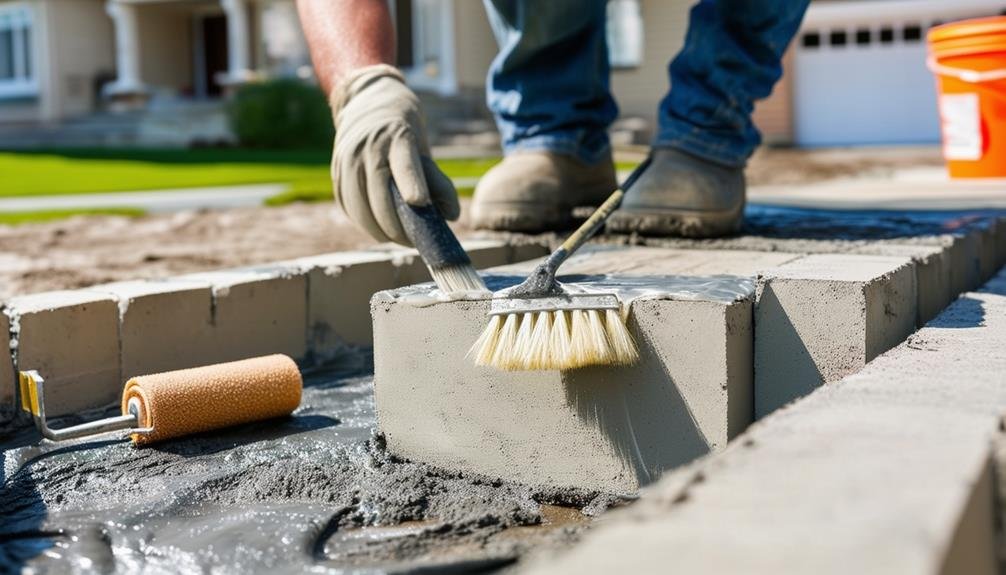
To start our waterproofing process, we’ll carefully clean and prepare the concrete block surface to guarantee superior adhesion of the waterproofing membrane. This is an essential step in our waterproofing techniques to secure long-term foundation protection. We’ll begin by removing any dirt, debris, or old paint using a wire brush or pressure washer. Once the surface is clean, we’ll inspect the blocks for any cracks or gaps and seal them with hydraulic cement or a high-quality sealant.
Next, we’ll apply a high-quality waterproofing membrane specifically designed for concrete block foundations in Guelph. Using a roller or brush, we’ll spread the membrane evenly across the entire surface, paying special attention to corners and edges. This creates a seamless barrier that prevents water intrusion.
For added protection, we’ll consider installing a drainage board over the membrane. This additional layer will help divert water away from the foundation, reducing hydrostatic pressure.
Common Waterproofing Mistakes
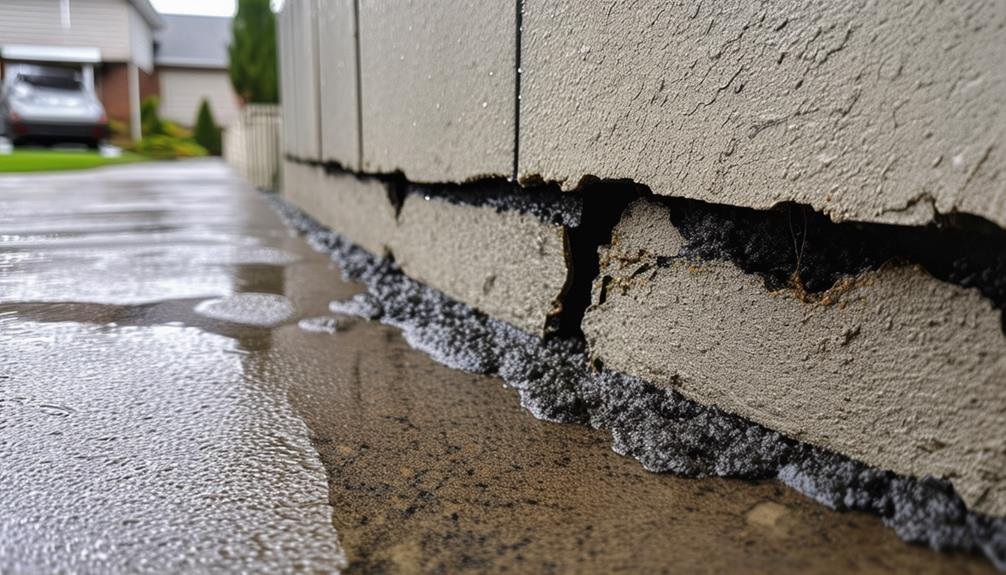
One of the most common waterproofing errors we observe is the failure to thoroughly prepare the concrete block surface, which can significantly impact the effectiveness of the waterproofing membrane. Proper surface preparation is vital for ensuring good adhesion of the waterproofing material. When we overlook this step, we set ourselves up for future problems.
Let’s explore other common errors:
- Neglecting Cracks and Gaps: Disregarding cracks and gaps in the concrete blocks can lead to water seepage, undermining the entire waterproofing endeavor.
- Incorrect Waterproofing Material: Using the wrong type of waterproofing material for concrete blocks can render the process ineffective. It’s necessary to choose a product specifically designed for concrete.
- Inadequate Drainage Solutions: Poor drainage around the foundation can compromise even the best waterproofing efforts. Without proper drainage, water will accumulate and eventually infiltrate the structure.
- Lack of Sufficient Coating: Failing to apply multiple layers of waterproofing material often results in inadequate protection. A single layer mightn’t be adequate to establish an effective barrier against moisture.
Maintenance Tips
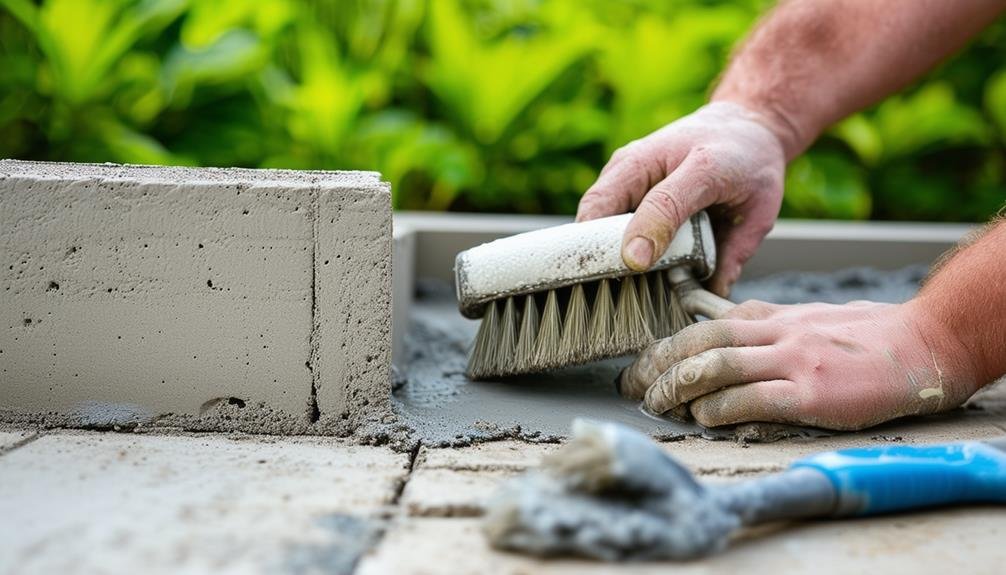
Now that we’ve identified common waterproofing mistakes, let’s focus on maintenance tips to keep your concrete block foundation in top shape.
Regular inspections are vital. We should routinely check for cracks, leaks, or any signs of water damage. Early detection can prevent minor issues from escalating into major problems.
Proper grading around the foundation is another essential aspect of foundation maintenance. The ground should slope away from the foundation, ensuring water doesn’t pool around the base. This simple yet effective technique can notably reduce the risk of water infiltration.
Applying a waterproofing sealer or coating, specifically designed for concrete block foundations, is also a smart move. This layer provides an additional barrier against moisture, enhancing the durability and longevity of the foundation.
Installing efficient drainage systems, like weeping tiles, helps manage water buildup around the foundation. These systems direct water away, preventing it from penetrating the concrete blocks.
Hiring a Professional Service

Choosing a professional service to waterproof our concrete block foundation ensures we benefit from specialized expertise and tailored solutions. Experts in Guelph, Ontario, possess the necessary experience to address the unique challenges of waterproofing these types of foundations. Their knowledge enables them to recommend the most effective techniques, ensuring our residence remains dry and secure.
When comparing DIY to professional services, it’s crucial to evaluate the advantages of hiring experts. While DIY methods may appear cost-effective at first, they often lack the durability and efficiency that professional services offer. Let’s explore a few reasons why professional services are beneficial:
- Skill: Professionals bring years of experience and specialized training, ensuring the task is completed correctly from the start.
- Guarantees: Many companies provide guarantees, providing us with assurance that the waterproofing will endure.
- Effectiveness: Trained technicians work swiftly and effectively, minimizing disruptions to our daily routines.
- Financial Analysis: Despite the initial cost potentially exceeding that of DIY, the long-term savings from preventing potential water damage and repairs justify the investment.
Frequently Asked Questions
What Is the Best Waterproofing for Block Foundation?
We believe the best waterproofing for block foundations involves combining exterior coatings and drainage solutions with interior sealants and basement insulation. This all-encompassing approach guarantees long-lasting protection and creates a dry, welcoming space for everyone.
How Do You Waterproof a Block Foundation From the Inside?
We acknowledge you might worry about excavation, but interior solutions offer effective waterproofing. Installing interior drainage systems keeps basements dry by channeling water away from walls and floors. It’s easy to maintain and highly efficient.
How to Waterproof a Concrete Foundation?
To waterproof a concrete foundation, we use exterior solutions like Bakor WP200 and guarantee proper drainage systems with weeping tiles connected to a sump pit. This method keeps our foundations dry and our homes safe from moisture.
How to Seal Concrete Block Basement Walls?
Like Odysseus facing challenges, we tackle sealing basement walls. Exterior vs. interior waterproofing matters; exterior is superior. DIY can work, but professional waterproofing guarantees durability. Address cracks first, then apply a high-quality membrane like Bakor WP200.
Conclusion
We’ve walked through the nuts and bolts of waterproofing a concrete block foundation, ensuring your Guelph home stays dry as a bone. By taking these steps, we’re not just patching cracks; we’re building a fortress against water intrusion.
Let’s keep our homes strong and our foundations firm. If you’re feeling out of your depth, don’t hesitate to call in the cavalry—a professional service can be a game-changer.
Stay proactive, and your foundation will thank you.
